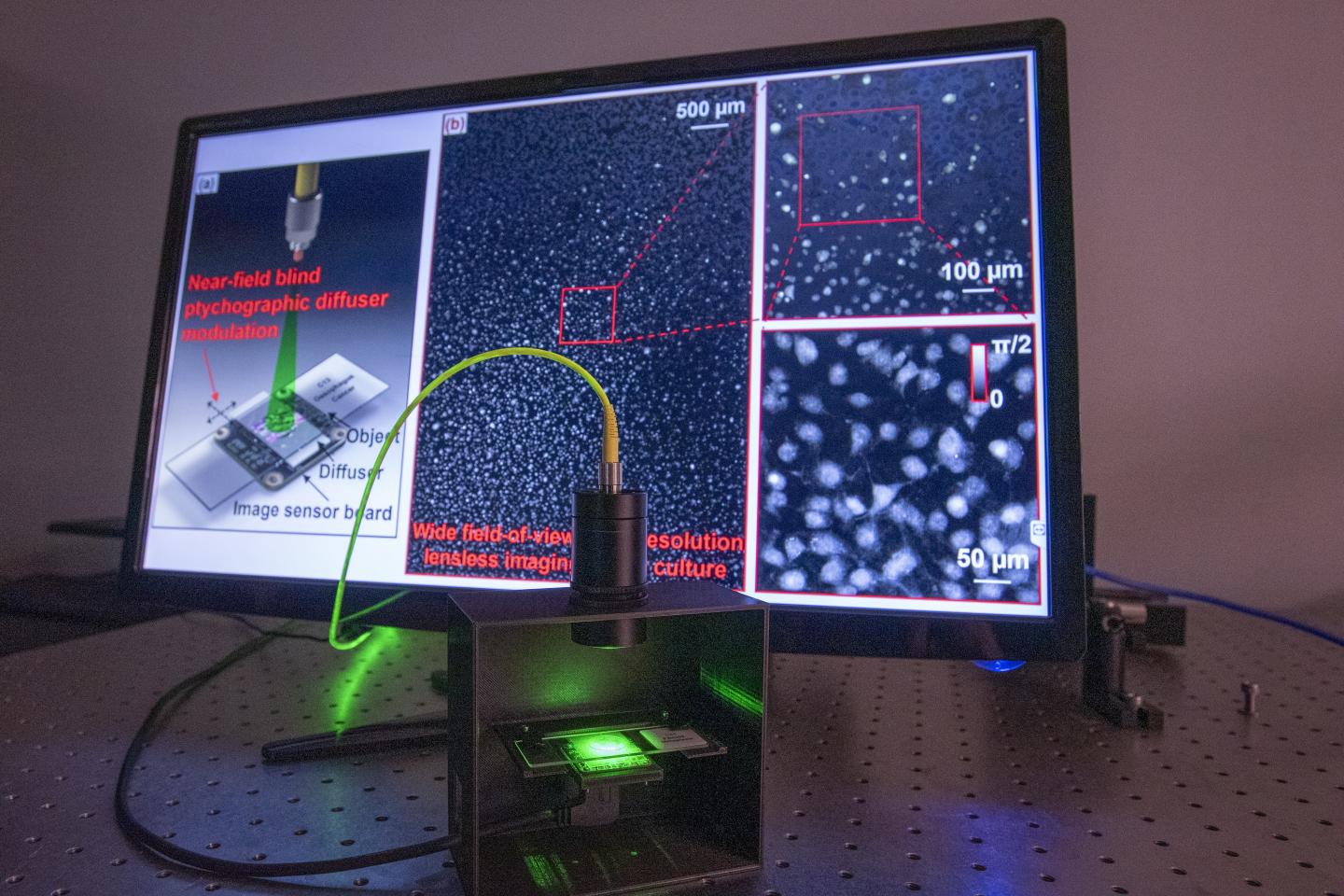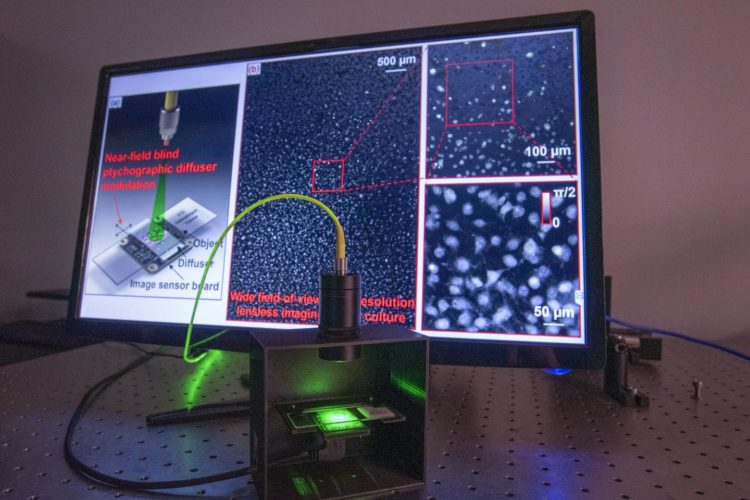UConn researchers develop low-cost, high resolution technology for improved optical imaging

Credit: Sean Flynn/UConn Photo
When you look through a microscope, whatever is on the stage is magnified to a degree the naked eye can hardly imagine. While traditional microscopy techniques allow miniscule details to come into view, standard equipment doesn’t provide us with the full picture.
Most optical microscopes have a limited field of view, only one to two millimeters. This is a major inconvenience for life scientists and pathologists who rely on microscopy to analyze and diagnose disease since prepared tissue samples have dimension in the centimeter range.
To address this unmet clinical need, a new microscopy platform developed at UConn removes a central component of traditional microscopes – objective lenses. By going lensless, researchers can actually provide clinicians a fuller picture, leading to more accurate diagnoses.
Guoan Zheng, a University of Connecticut professor of biomedical engineering, recently published his findings on a successful demonstration of a lensless on-chip microscopy platform in Lab on a Chip. This platform eliminates several of the most common problems with conventional optical microscopy and provides a low-cost option for the diagnosis of disease.
Rather than using lenses to magnify the tissue sample, Zheng’s platform relies on a diffuser that goes between the specimen and the image sensor or camera. The diffuser randomly moves to different positions while the sensor acquires the images, gathering the encoded object information that will later be used to recover an image for viewing by clinicians or researchers.
At the heart of the object recovery process is an imaging technique called ptychography. Ptychographic imaging typically uses a focused beam to illuminate a sample and record the pattern created by the diffracted light. To recover an entire complex image – like a tissue sample – for viewing, ptychography requires thousands of patterns to be recorded while scanning the sample to different positions.
“Although ptychography has been of increasing interest to scientists around the world, broad implementation of the method has been hampered by its slow speed and the requirement of precise mechanical scanning,” says Shaowei Jiang, a UConn graduate student and the lead author of the study.
Zheng’s new ptychographic technology addresses these issues by bringing the sample close to the image sensor. This new configuration allows the team to have the entire image sensor area as the imaging field of view. In addition, it no longer requires the precise mechanical scanning needed for traditional ptychography. This is because the new configuration has the highest Fresnel number ever tested for ptychography, approximately 50,000. The Fresnel number characterizes how a light wave travels over a distance after passing through an opening, such as a pinhole. The ultra-high Fresnel number used in Zheng’s experiments indicates that there is very little light diffraction from the object plane to the sensor plane. Low levels of diffraction mean that the motion of the diffuser can be directly tracked from the captured raw images, eliminating the need for a precise motion stage, which is critical for conventional ptychography.
“This approach cuts down on processing time, cost, and allows for a more complete image to be produced of the sample,” says Zheng.
With conventional lensed microscopy, scientists can only view a small portion of a slide during each viewing. Zheng’s platform offers a major improvement by effectively expanding the microscope’s field of view. Zheng’s current prototype offers a 30 mm2 field of view, compared to the standard ~2 mm2. By using a full-frame image sensor in a regular photography camera, Zheng’s technology allows physicians to analyze two entire slides at once.
“Imagine being able to read a whole book at once instead of just a page at a time. That’s essentially what we hope our technology will allow clinicians to do,” says Zheng.
Adding to its already long list of improvements, Zheng’s platform eliminates the need for cell staining. Normally, scientists stain parts of cells, like the nucleus, to identify how many there are. Zheng tested this platform’s ability to perform automatic cell segmentation using the recovered label-free phase maps.
Due to its compact configuration and robust performance, Zheng and his team envision that their platform would be a good fit for use in a range of point-of-care, global health, and telemedicine applications. Their technology can also be useful for X-ray and electron microscopy.
“By using our lensless, turnkey imaging system, we can bypass the physical limitations of optics and acquire high-resolution quantitative information for on-chip microscopy. We’re excited to continue to refine this technology for commercial and clinical applications to have a tangible impact for patients and researchers,” Zheng says.
###
Media Contact
Jessica McBride
[email protected]
860-878-5058
Original Source
https:/
Related Journal Article
http://dx.





